-
收藏模板下载模板
- 模板信息
- 更新时间:2023-09-09
- 字数:约53287字
- 页数:约38页
- 格式:.doc
- 推荐版本:Office2016及以上版本
- 售价:5 金币 / 会员免费
您可能喜欢的文档
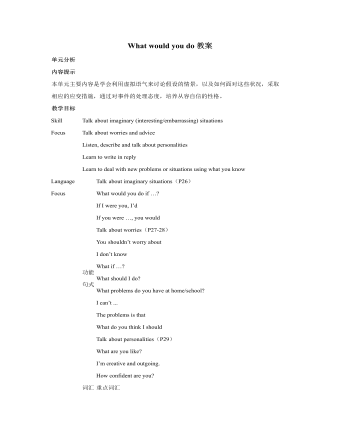
人教版新目标初中英语九年级上册What would you do教案
本课采用任务型教学法,用What would you do if you had a million dollars?这个问句,引出谈论假想情况的话题。 采用提问、启发和归纳的教法,让学生易于接受教材内容,培养学生的语言运用能力。 四、 教学过程设计 Step Ⅰ. Greet the whole class as usual. Step Ⅱ. Warming-up T: Do you have ten Yuan in your pocket? S1: No, I don’t. T: (Take out ten Yuan and give it to the student) OK, never mind. What would you do if it was yours? What would you do if you had ten Yuan? S1: I would buy snacks. T: OK, thank you. Sit down, please. (To the whole class) Just now, it was only ten Yuan. What about 100 Yuan? What would you doif you had 100 Yuan? S2: I’d buy a beautiful jacket. T: Thank you. (To the whole class) Now suppose you had a million dollars, what would you do? We know thatone dollar nearly equals eight Yuan, so that’s a large sum of money. Think it over carefully and tellme your ideas. What would you do if you had a million dollars? S3: I’d buy a big house. S4: I’d buy a sports car. S5: I’d put it in the bank. T: OK, stop here. Please look at the blackboard and guess what would I do if I had a million

人教版新目标初中英语九年级上册I like music that I can dance to教案
教学目标: 1. Express preferences2. Talk about one’s likes and dislikes and the reasons3. Learn to express one’s opinions 4. Learn to write a reply 语言功能: 1) Talk about one’s preferences, using t he relative clause2) Talk about people’s likes and dislikes and the reasons3) Talk about opinions语言结构: Relative clauses with that and who语言目标:What kind of music do you like?I like music that I can sing along with.I love singers who write their own music.We prefer music that has great lyric.重点词汇及短语:heart, photography, interest, class, whatever, miss, okay, expect, sweet, taste, itself, laboratory, cancer, increase, biscuit, main, care, prefer… to…, remind somebody of …, dance to, sing along with, be sure to, interest somebody, make somebody adj., to be honest, suit somebody, on display, catch up教学重难点:What do other people think of the different kinds of things? How to express one’s opinions? 学习方式:讨论,合作学习情感目标:通过本单元的学习,能提高学生的艺术鉴赏能力和审美情趣,并引导学生养成健康的饮食习惯。课时安排5课时第一课时:Section A: 1a-2c第二课时:Section A : 3a-4第三课时:Section B:1-2c, Self check2第四课时:Section B: 3a-4, Self check1第五课时:Self check ReadingI like music that I can dance to.
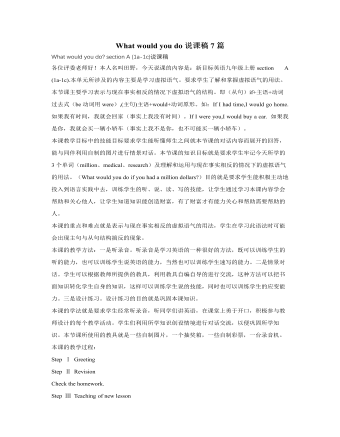
人教版新目标初中英语九年级上册What would you do说课稿7篇
Get students to complete the activity in groups of four. As the groups work together, move around the room to make sure students discuss the topic in English and know how to fill in the chart.Check the answers by asking different pairs of students to say their conversations to the class.Answers will vary.Optional activityAsk, What would you do if there were no classes tomorrow? Ask students to write as many answers as they can. Then get students to work in pairs. One ask the other the question and see how many new answers the other is able to think of.Step Ⅴ SummarySay, In this class, we've done a lot of reading, speaking and writing practice using the target language.Step Ⅵ Homework(1) Review the target language by reading the conversations in Activity 3a.(2) Finish off the exercises on pages 11~12 of the workbook.Step Ⅶ Blackboard DesignWhat would you do?Section AThe Third PeriodTarget language:A: I can't sleep the night before an exam. Then I'm too tired to do well. What should I do?B: If I were you, I'd take a long walk before going to bed. That should help you relax.A: I really want a dog, but my parents won't let me have one.B: Well, dogs can be a lot of trouble. Maybe you should get a small pet, like a goldfish.A: That's a good idea.

人教版新目标初中英语九年级上册Teenagers should be allowed to choose their own clothes教案2篇
Step 1 Greeting Greet the class and check the homeworkStep 2 A duty report The S on duty gives a report on the rules in his home and lead in 3a “Sun Fei’s and Wu Yu’s rules” Step 3 ReadingSs read the conversation and write the two girls’ rules in the chart. Check the answers.Get Ss to read after the tape and then read aloud by themselves. Then, T explains the language points.Step 4 Pairwork 3bRole play. Use the information in chart to practice with the conversation in 3a covered. They can look at the sample conversation in the right box.Step 5 Task 2 “Who’s the best reporter?”Make a survey by asking any 5 students the questions in the chart in activity 4. Then give out a report about it. See who is the best reporter? And the best reporter will get a nice ball-pen.Step 6 Summary and homework:Write out the report in your exercise-books.Period ThreeStep 1 Greeting and a duty reportThe S gives a duty report talking about his experience of being late for school. Lead in the question “Do you ever get to school late? How often do you get to school late? Always, usually, sometimes, or never?Step 2 1a Get Ss to finish writing.Step 3 Pairwork 1b Get Ss to talk about their answers with their partners using the sample conversation in the box on the right.Step 4 Listening practice2a Lead-in: What will happen if you get to school late? What about Peter? Let’s listen to a conversation between Peter and his father. Get Ss to finish 2a (As usual, for the first time, Ss only listen.) Check the answers.
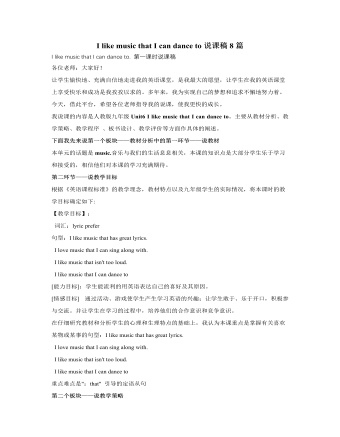
人教版新目标初中英语九年级上册I like music that I can dance to说课稿8篇
2、 难点结合功能句进行听力练习。确定目标的根据新课程标准规定,通过听、说、读、写的训练,使学生获得英语基础知识和初步运用英语进行交际的能力,激发学生的学习兴趣,为进一步的学习打基础。此外,根据我国国情及新课程标准的要求,现阶段英语教学的素质主要包括思想素质教育,潜在英语能力的培养,非智力因素的培养等几个方面。而我们班的学生本身英语基础不太好,部分学生已经对英语失去了信心,还有一部分学生觉得英语越来越难,渐渐力不从心了,不感兴趣了,上课注意力也不集中了。针对这种情况,备课时要增加趣味性,以此来提高学生对英语的学习兴趣。二、教法学法1、 教法:采取“任务型”教学法。教师根据本节课内容,安排合适的任务,让学生在完成任务的过程中达到本节课所拟定的目标。
- 查看更多相关Word文档
Where would you like to visit教案2篇
Where would you like tovisit?教案一
The First Period
Ⅰ.Teaching Aims and Demands
Knowledge Objects
(1) Key Vocabulary
tiring, educational,fascinating, thrilling, peaceful, exotic, trek, jungle, take it easy,
 explore,historic, site
explore,historic, site
(2) Target Language
Where would you like to go onvacation?
I’d like to trek through the jungle, because I likeexciting vacations.
2. Ability Objects
(1)Train students to talk about places they would like to visit withthe target language.
(2)Train students to describe vacations with different adjectives.
(3)Train students listening skill.
3. Moral Object,
It′s more interesting to go onvacating somewhere instead of staying at home.
Ⅱ. Teaching Key Points
1. Key Vocabulary
tiring, educational, fascinating, thrilling,peaceful, exotic, trek, jungle, take it easy, explore, historic, site
2. Target Language
Talk about different placeswith the target language.
Ⅲ. Teaching Difficult Points
1. Describe vacations with different adjectives.
2. Talk about different places with the targetlanguage.
Ⅳ. Teaching Methods
1. Teaching by illumination
2. Teaching by doing chain drills
3. Teaching by pairwork
Ⅴ. Teaching Aids
1. A tape recorder
2. Some pictures of different places with famous views
Ⅵ. Teaching Procedures
Step Ⅰ Revision
1. Revise the language points in Unit 6.
Provides some questions, Whatkind of music do you like/love/prefer? What kind of clothes/writers/movies/… do you like/love/prefer?
Then ask two pairs to makemodel conversations to the class to make sure they answer, I like/love/prefermusic that…I prefer writers who…
Next ask students to practisein pairs.
Walk around the classroomlistening to them, correct some errors they may make and be sure they areanswering with sentences with relative clauses.
2. Revise the words and expressions in by dictatingthe following:
lyric, remind of,entertainment, exhibition, gallary, on display, energy, suggest, photograph,suit
Step Ⅱ 1a
At first introduce the keyvocabulary.
Point to the words and teachthe children to read them several times till they can pronounce the wordsfluently and correctly.After that, try to let students explain the adjectives and make upsentences with them. For example, exciting, do like this:
Let’s try to explain some newadjectives in our own words and make up some sentences now. See exciting first. Who can explain it in your ownwords in English?
What does exciting mean?
Help the children to explain it. Exciting means not boring, ormeans hard to be quiet.
Who can make up a sentence withit?
Give an example sentence withit, please.
Ask several ones to say theirsentences to the class. For example,
Surfing makes us exciting.
The boy is very exciting whenhe is watching a football match.
Then do the same with these newwords in the box:
tiring, educational, peaceful, fascinating, thrilling, exotic |
Read the instructions to thestudents. Besure that everyone knows what to do.
Tell students to look at theposters in the picture and compare them.
We can see three posters. Tell me what you can see ineach one.
Then discuss the three posterswith students. For Poster One, help students to say, It is a beach. A man with sunglasses issleeping, etc.
Do the same to the other twoposters.
Read the words on each posterto students and then let them read together several times. Ask some ones to tell theChinese meanings of the words to see if they can understand them. Do some explanation ifnecessary.
Call the students attention tothe chart.
Point to vacation 1,2 and 3 inthe chart.
Say, Let’s choose the adjectives fromthe box for the three vacations. The adjectives you choose should correspond with the posters. Now let’s use Vacation 1 as a sample. Which adjectives should wechoose? Who can tell me?
Then ask several students totell the class the words they’ve chosen. Write down their answers on the blackboard like this:
Vacation 1 Take it easy on aFlorida beach!
Adjectives: relaxing, peaceful,boring
Who has got some otheradjectives to describe it? Some other adjectives you know, but not in the box?
Ask some to say more besidesthe ones in the box, such as quiet, lazy.
Write them on the blackboard,too.
Please fill in the chart withthe adjectives now. Note to match the posters.
Get them to fill in the answersby themselves. As they work, move around the room checking their progress and answeringquestions they may have.
Check the answers.
Step Ⅲ 1b
We’ll listen to three studentstalking about where they would like to go on vacation and why. See the sample answers in thechart. Writeyour answers like that while you hear. Look at the three posters in Activity la and dothis part. Each one of the three students, Sam, Gina and Lydia, wants to goto one of the three places.
Play the tape for the firsttime, and tell the students not to write in a hurry, just try to catch the mainidea of the dialogue.
Then play the recording again. Ask them to write theiranswers this time.
Check the answers.
Step Ⅳ 1c
Presentate this dialogue,showing some pictures of the places with great interest all over the world andsay like this:
I’d like to travel to France. I’d love to visit Paris, becauseI like relaxing vacations.
Where would you like to go onvacation, Sam?
Ask one student to answer thequestion.
After that let him or her askanother student. Set off a chain drill like this:
T: I’d love to visit Paris, becauseI like relaxing vacations. Where would you like to go on vacation, S1?
S1:I’d like to climb Mount Emei,because I like dangerous vacations. Where would you like to go on vacation, S2?
Ss :I prefer totravel to the USA, because I like exotic vacations. Where would you like to go onvacation, S3?
S3
After a team finished get thechildren to make their own conversations in pairs.
Ask two students to read theexample in the speech bubbles in Activity la. Tell them to talk about the posters with theirpartners this time.
As students work together, movearound the classroom, offering language support as needed. Ask some pairs to say theirconversations to the class.
Step Ⅴ Summary
In this class, we’ve learned some adjectives thatare used to describe vacations and some other words. We have also learned thetarget language—Where would you like to go on vacation? I’d like to trek through thejungle because I like exciting vacations.
Step Ⅵ Homework
1. Try to remember the new key vocabulary.
2. Write out three similar conversations to theexample in the picture in Activity 1a.
Step Ⅶ Blackboard Design
Where would you like to visit? Section A The First Period Possible answers to Activity 1a: Vacation 1: relaxing, peaceful, boring Vacation 2: exciting, tiring, dangerous, educational, fascinating, interesting, fun, thrilling, exotic Vacation 3: exciting, educational, peaceful, interesting |
The Second Period
Ⅰ. Teaching Aims and Demands
1. Knowledge Objects
(1) Key Vocabulary
fall, Niagara Falls
(2) Target Language
Where would you like to visit?
I’d like/hope to visit/see
I’d like/love places where
2. Ability Objects
(1)Train students listening skill.
(2) Train students communicative competence.
3. Moral Object
It can make you know more about the world totravel much.
Ⅱ. Teaching Key Points
1. New words fall, Niagara Falls
2. Listening practice with target language
3. Make communications with target language
Ⅲ. Teaching Difficult Points
1. Train students listening practice with targetlanguage.
2. Help students to make communications with targetlanguage.
Ⅳ. Teaching Methods
1. Listening 2. Pairwork 3. Explanation
Ⅴ. Teaching Aids
1. A tape recorder
2. Some pictures of Hawaii, Mexico and Niagara Falls
Ⅵ. Teaching Procedures
Step Ⅰ Revision
(1) Revise the target language by asking question, Where would youlike to go on vacation?
Get several students to givedifferent answers.
Then ask them to work in pairsto practise with:
Where would you like to go onvacation?
I’d like/love to…because I like… vacations.
(2) Check homework by asking several ones to read their conversations.
(3)Check homework by dictating the following words:
tiring, educational,fascinating, thrilling, relaxing, dangerous, exotic, trek. jungle, take it easy, explore,historic
After dictating, hove studentscheck in pairs. Make a survey by asking them to put up hands to see how many havewritten out all the words correctly.
Step Ⅱ 2a
Read the instructions to thestudents.
Look at the four sentences inthe box.
They are from a conversation,but they are not in the right order. We will listen to a conversation talking aboutgoing on a vacation. We can see the number in from of the fourth sentence. It’s a sample answer
Please write the right numbersbefore the first three sentences in the blanks.
Then play the tape. Students only listen this time. Try to catch the main idea ofthe conversation. Next play the tape again. Students listen and write the numbers in the blanks.
Check the answers.
Step Ⅲ 2b
This activity provideslistening practice using the target language, too.
Read the instructions tostudents, and make sure that they know what to do.
Look at the first column,"Place". Someone doesn’t like going to these places.
Why? Choose the reason for eachplace from the second column. Write the letters of the reasons in the blanks before theplaces/Let’s read the contents in the chart first. Get them to read the placesand reasons several times. Then say, we’ll listen to the same recording again. Listen and match each placewith a reason for not going there. Play the recording again.
Ask students to fill in theiranswers.
Check the answers
Step Ⅳ 2c
Read the instructions to thestudents. Tellthem to use the information in Activities 2a and 2b to role play conversations.
(Holding a picture of Hawaii). I hope to visit Hawaii some day.
Get a student to answer, So doI. I likeplaces where the weather is always warm.
Showing a picture of Mexico,ask two students to make up similar conversations. Note to use the information in Activities 2a and 2b.
Do the same with the thirdplace Niagara Falls.
Say, Now please role play theconversations in pairs, using the information in Activities 2a and 2b. Each pair makes one at least. As the students work, movearound the room checking progress of the pairs and offering help as needed. Ask one or two move pairs tosay their conversations to the class.
Step 5 Grammar Focus
Presentate the conversationbelow by saying to the students and writing it on the blackboard:
Where would you like to visit?
I’d like to go somewhere relaxing.
Draw a line under the wordrelaxing.
Then ask the children the samequestions and tell them to answer in their own words. For example,
I’d like to go somewhere interesting.
I’d like to go somewhere exotic.
After asking several childrento give answers with different adjectives, get them to practice in pairs. Each pair makes twoconversations.
Next ask several pairs to sharetheir conversations with the class.
Then say, the adjectivesusually come before the nouns, such as, an educational vacation, a tiring trip. But in the sentences which areusing the word something or somewhere, the adjective should be put after thepronouns. Forexample:
I’d like to go somewhere fascinating.
I’d love to eat something delicious.
After that, presentate anotherpair of sentences. Say to the students and write down on the blackboard:
Where would you like to visit?
I hope to go to France some day.
Explain sentences with some dayin English orally, like this,
I hope to go to France some day. This sentence means I hope togo to France some day, but I’m not sure I will. Maybe I will go there in the future and maybe I won’t. The sentences with some day are often used toexpress that.
Then have the children make upmore sentences.
Step Ⅵ Summary
In this class, we’ve done some listening practicewith target language. We have also practiced our oral English in pairs.
And we’ve discussed something on grammar.
Step Ⅶ Homework
1. Write out two pairs of sentences like this:
Where would you like to visit?
I’d like to go somewhere relaxing.
Where would you like to visit?
I hope to go to France some day.
2. Practice the target language orally with theclassmates.
Step Ⅷ Blackboard Design
Where would you like to visit? Section A The Second Period Ⅰ. Answers to Activity 2a: 3 4 2 1 Ⅱ. Answers to Activity 2b: 1. b 2. a 3. c Ⅲ. Grammar Focus: 1. Where would you like to visit? I’d like to go somewhere relaxing. 2. Where would you like to visit? I hope to go to France some day. |
The Third Period
Ⅰ. Teaching Aims and Demands
1. Knowledge Objects
(1) Key Vocabulary
touristy, spotlight"Singapore, beautiful, heavy, private, downtown, get around, Pack, light
(2)Target Language
Where would you like to go,Kathy?
I’d like to visit Kunming.
2. Ability Objects
(1) Train students reading skill.
(2) Train students skill of communication.
3. Moral Object
Share your experience ontravelling in a city with your classmates and tell them what they should bringif they decide to visit it.
Ⅱ. Teaching Key Points
1. Guide students to read the passage in Activity 3a.
2. The new vocabulary
Ⅲ. Teaching Difficult Point
Help students to talk to theirpartners about the cities they know.
Ⅳ. Teaching Methods
1. Teaching by illumination.
2. Teaching by asking questions.
Ⅴ. Teaching Procedures
Step Ⅰ Revision
1. Revise the target language they learned last classby asking Where would you like to go on vacation? Get several children toanswer I’d liketo…because
2. Check the homework by asking some children to readthe conversations they wrote to the class.
Step Ⅱ 3a
At first introduce the keyvocabulary words.
Teach students to read thevocabulary several times until they can read them out easily and correctly.
Read the passage quickly andtry to answer the questions on the blackboard.
Write these questions on theblackboard:
1. What doesn’t Singapore have?
2. What does Singapore have?
3. Is Singapore also a wonderful place for shopping?
4. What don’t you plan on doing in singapore? why?
5. What is easiest to do in Singapore?
6. What is suggested to bring if you decide to gothere? Why?
A few minutes later(maybe two or three minutes), ask different students toanswer the questions.
Play the video tape ofSingapore for students or show them some pictures.
Next, read the instructions tostudents.
Say, What things do you likeabout visiting Singapore and what things don’t you like? Read the passage again. Circle the things you likeabout visiting Singapore and underline the things you don’t like.
Get them to finish the activityon their own.
Check the answers.
Step Ⅲ 3b
Read the instructions tostudents. Makesure that they know what to do.
Ask two students to read thesample conversation on the left in Activity 3b,
Note to correct anypronunciation errors to make sure the students are providing a good model forthe rest of the class.
Ask another pair to model aconversation with the first group of words on the right, the words in the firstline. Listento them carefully with the whole class to see if they can put the words in theproper places. Then let the whole class practice in pairs. Each pair should make up fourconversations with the information on the right. Walk around the classroom as the students areworking. Listento some pairs and see if they have met any problems. Offer some help as needed. After all the students havefinished practicing, ask some more pairs to share their conversations withtheir classmates.
Step Ⅳ Part 4
Read the instructions to thechildren.
Make sure that they understandit.
Say, First think of a city youknow, everyone. I think of Dalian. What about you?
Ask several ones to tell thenames of the cities they’ve thought of.
Then say, Please write down thename of the city you’ve thought of on the line above city name in the chart.
After that, show some photos ofDalian to the students around the room. Then continue saying, Dalian is a very beautifulcity with wonderful beaches. It has very long coast. It also has quite a few big and nice parks. Some are near the sea and someare not. I like thebig museum of different kinds of sea animals, too. What about you? What do youlike about the cities you’ve written in your book?
Ask two or three to saysomething about their cities.
Then say, Now please fill inthe left box with the things you like about the city.
I’ll write mine on the blackboard, you can use it as asample.
Write the sample on theblackboard, and students write out theirs.
Walk around the classroom anddirect them to write.
After all of them havefinished, go on with the third step.
Now talk to your partner aboutthe things you don’t like.
After they finish talking, goon saying something I don’t like about Dalian to them.
For example, The things inDalian are too expensive.
They are for the rich. And there are too many carsrunning on the streets. It’s very hard for people to cross a street.
Can you say something you don’t like about your cities?
Ask some to say something onthat to the class. Then tell them to fill in the box for things you don’t like. Let them talk to their partnersabout it.
Step Ⅵ Summary
In this class, we’ve learned something aboutSingapore, and we’ve talked about some other places all over the world.
We’ve done a lot of listening,speaking, reading and writing practice using the target language.
Step Ⅶ Homework
1. Write a short passage on the city you talked aboutin class.
2. Try to remember the new words on page 54.
Step Ⅷ Blackboard Design
Where would you like to visit? Section A The Third Period Questions to Activity 3a: 1. What doesn’t Singapore have? 2. What does Singapore have? 3. Is Singapore also a wonderful place for shopping? 4. What don’t you plan on doing in Singapore? Why? 5. What is easiest to do in Singapore? 6. What is suggested to bring if you decide to go there? Why? Sample answers to Activity 4: Dalian Things you like 1. wonderful beaches 2. long coast 3. big and nice parks 4. the big museum of different kinds of sea animals Things you don’t like 1. things are too expensive 2. too many cars running in the streets |
The Fourth Period
Ⅰ. Teaching Aims and Demands
1. Knowledge Objects
(1)Key Vocabulary
customer, save money, pool,culture, dream vacation, travel agency
(2)Target Language
Where would you like to go?
I’d like to go somewhere warm.
2. Ability Objects
(1)Train students listening ability.
(2) Train students to use the target language in oral Englishproperly.
3. Moral Object
To role play the conversationsyou’veheard is a very good way to improve your oral English.
Ⅱ. Teaching Key Point
Train students listening skillby listening to the conversations with the target language.
Ⅲ. Teaching Difficult Point
Help students to role play theconversations.
Ⅳ. Teaching Methods
1. Brainstorm
2. Listening method
3. Pairwork
Ⅴ. Teaching Aid
A tape recorder
Ⅵ. Teaching Procedures
Step Ⅰ Revision
1. Revise the passage about Singapore by asking two orthree students to read it to the class. Make sure that they pronounce each word correctly.
Then let students read it aloudonce by themselves.
2. Check the short compositions they have written athome. Firstlet several ones read theirs to the class. Second, get them to work in pairs to check thecompositions. At last, collect all students compositions. Go over them carefully afterclass.
Step Ⅱ Part 1
This activity reviews thetarget language and introduces new vocabulary.
Read the instructions tostudents.Explain brainstorm like this:
Brainstorm a list of thingsmeans you should write down all the ideas that come into your minds.
Now brainstorm a list of thingsthat are important to you when you go on vacation. Write them down in your exercise books. You should not worry if anidea is silly or if a word is spelled wrong. You can even write a word in their first languagefor the moment.
Ask them to have a look at thetwo model phrases the book provides before they begin. Move around the room offeringlanguage support as needed.
After about three minutes, tellthem to stop writing and thinking.
Let’s review the ideas you’ve thought of together. We will correct spelling andfind the correct English words for any words you don’t know.
Then ask some children to readtheir lists to the class. Write any new words or
phrases they have used on theblackboard. Ask them to discuss the lists in groups of four. Each one reads his or her ownlist to the other three. Then they discuss the words or phrases together. If there is something thatthey are not sure, tell them to show me by putting up their hands. Move around the room and solvethe problems they may have. Help students find the correct English words to express theirideas.
Step Ⅲ 2a
Read the instructions tostudents. Tellthem to guess the meaning of travel agency first. Then explain it like this:
If you plan to have a trip orvacation, you can go to a travel agency. A travel agency is an office that can help you maketravel plans. Also they help you get plane tickets and hotel reservations. Then presentate whale watch andamusement park to the class like below. A whale watch tour means you stay in a ship and goout to the oceaning during the time of year when the whales are migrating, thenyou can see them travelling. Amusement park means a place like disney land. You can do lots of rides andplay lots of games there.
Write the two phrases on theblackboard.
Look at the three pictures inActivity 2a now. We know Jeff has a summer job at a travel agency. We will hear him talking onthe phone with three different people.
Can you see the small box inthe corner of each picture? Listen to the conversations and number the pictures. Write a proper number in eachbox to show the right order of the pictures. Then play the tape for the first time. Tell them only to listen. Play the tape a second time. As they listen to the tapethis time, have the students number the pictures.
Check the answers.
Step Ⅳ 2b
Read the instructions to thechildren.
Tell them to look at the chart. Then read the headingsCustomer, Wants, Doesn’t want and point out the blanks under each one. And let them see the sampleanswer under Wants in the chart. Ask them to read it together. Say, Then first customer wants to go somewhere warm.
I’ll play the recording again. Please write down the thingsthe three customers want and don’t want in this chart as you listen to the recording.
The play the recording again. Students fill in the blankswith the words they hear. Pause the tape several times to give students time to fill outthe chart.
Correct the answers.
Step Ⅴ 2c
This activity provides guidedoral practice using the target language.
Read the instructions to thechildren.
Say, In this activity, you areasked to role play Jeff’s conversation with the information in the chart in Activity 2b.
Ask a pair of students to readthe sample conversation to the class.
Offer more phrases,…to go to a small town,…to go by ship,…to go to a place which is toocrowded, …to travel by plane,…to go to anywhere too far, ect.
Write them on the blackboard.
Then ask students to practicein pairs.
Move around the room checkingthe progress of the pairs and offering help as needed. Ask one or two pairs to saytheir conversations to the class. Correct any mistakes they may have made.
Step Ⅵ Summary
Say, In this class, we’ve done lots of listeningpractice on target language, and we’ve also written and spoken some.
Step Ⅶ Homework
1. Write out the phrases you have brainstormed in Activity1.
2. Write down the conversation in Activity 2c.
Step Ⅷ Blackboard Design
Where would you like to visit? Section B The Fourth Period The answers to Activity 2b: Customer 1 wants: to go somewhere warm, doesn’t want: to fly Customer 2 wants: to go on a nature tour, doesn’t want: to to anywhere cold Customer 3 wants: to go somewhere that’s fun for kinds, doesn’t wants to go to a big city Some phrases for Activity 2c: to go to a small town to go by ship to go to a place where is too crowded to travel by plane to go to anywhere too far |
The Fifth Period
Ⅰ. Teaching Aims and Demands
1. Knowledge Objects
(1) Key Vocabulary
provide, firm, offer, spot, Confucius, stele,forest
The Forest of Steles
(2) Reading practice using the target language
(3) Writing practice using the target language
2. Ability Objects
(1) Train students reading skill.
(2) Train students writing skill.
(3) Train students listening and speaking skills.
3. Moral Object
Are you planning to take a tripthis summer?
Write an e-mail to a travelagency in English to get some information on vacations.
Ⅱ. Teaching Key Points
1. The new vocabulary.
2. Read an e-mail.
3. Write an e-mail.
Ⅲ. Teaching Difficult Point
Write an e-mail.
Ⅳ. Teaching Methods
1. Scanning the e-mail to find out the answers
2. Writing
3. Groupwork
Ⅴ.Teaching Procedures
Step Ⅰ Revision
1. Revise the conversation in Activity 2c on page 55by making a conversation with one student like this,
T: Where would you like to go?
Ss: I’d like to go somewhere relaxing.
T: What else can you tell me?
S: I don’t want to go to big noisycities.
After that, ask them topractice in pairs.
Ask several pairs to sharetheir conversations with the whole class.
2. Check their homework.
Step Ⅱ 3a
This activity provides readingpractice using the target language.
At first, introduce the keyvocabulary words.
Teach students to read thewords and expressions several times. Then ask several to read to the class. Make sure that they can readthe words fluently and correctly.
Read the instructions tostudents. Make sure that each student knows what they will have to do.
Go over the statements aboutthe e-mail message with the whole class. Make sure that they can understand all the sixsentences in the box. And tell them to put the six statements in their minds while theyscan the e-mail below.
Say, Boys and girls, pleasescan the e-mail in Activity 3a now. Try to get the main idea of the letter and find outthe answers to the statements. Ask them to scan the letter individually, and write T, F or DKbefore each statement.
After they’ve all finished scanning, checkthe answers with the whole class. Elicit why the false sentences are false at the same time.
After checking the answers,tell the children to read the passage more carefully and prepare to answer thequestions on the blackboard.
After they’ve all finished reading, getsome students to answer these questions.
Encourage them to ask questionson what they don’t understand about the e-mail.
Ask one student to read theletter to the class. Help him or her with the pronunciation. Then let all the students readthe passage several times.
Step Ⅲ 3b
Read the instructions tostudents.
Ask: Who can explain theinstructions in your own language?
Choose two or three among thosewho have put up their hands to explain the instructions in English.
They may say like this, SupposeI work for Ace Travel Agency and I have received the letter from S.T. Zhang. Then it is my duty to reply the e-mail and I haveto tell where they should go on vacation.
After they all know what to do,get them to begin writing. Move around the classroom as they write, offering help ifnecessary. Remember whose passage is excellent and prepare to ask them toread theirs to the class.
After they’ve all finished writing, askthe students who have written very good passages to read theirs to the class.
Let them work in pairs tocorrect the mistakes in the passage they’ve written.
Tell them that they have torewrite the letters after class and bring them to school tomorrow.
Step Ⅳ Part 4
Read the instructions tostudents.
Say something about the threeplaces in the chart. Showing some pictures of these places to the students, say likethis, Qufu is a small city in Shandong Province.
It is famous for Confucius. It was Confucius’ hometown. He was born there.
The Great Wall is the pride ofthe Chinese people. It is very long and it is hard to believe that it was built overtwo thousand years ago.
The Forest of Steles in Xi’an is a great place for peoplewho are interested in writing Chinese with brushes.
What do you think of the threeplaces?
Look at the chart in Activity 4. We can see the sample answerin the box about Qufu in the column of you.
Continue saying, Now pleasefill in the boxes about The Great Wall and The Forest of Steles in Xi’an on your own.
You can use the words above thechart or any other word.
Tell them to write out thethree students names in the proper places in the chart.
Then get them to survey thethree students. Let them work in groups of four.
Ask a pair of students to readthe model conversation in Activity 4 before they begin their own ones.
At last, have several groupsreport the results to the class. Then ask the class where they would prefer to go together.
Step Ⅴ Summary
In this class, we’ve read an e-mail to a travelagency and we’ve also written an e-mail. And we’ve done some reading, writing, listening andspeaking practice using the target language through group work.
Step Ⅵ Homework
1. Rewrite the e-mail which you wrote in class.
2. Try to remember the new words and expressions onpage 56.
Step Ⅷ Blackboard Design
Where would you like to visit? Section B The Fifth Period Answers to Activity 3a: 1. F 2. F 3. DK 4. DK 5. T 6. F Questions on the e-mail in Activity 3a: 1. Where do S.T. Zhang and the family want to take a trip? 2. What kind of place do they want to go to? 3. What exercise do they especially love doing? 4. What does S.T. Zhang say about the hotel they want to live in? 5. What does S. T. Zhang want the travel agency to do? 6. How long would they like to be away? |
The Sixth Period
Ⅰ. Teaching Aims and Demands
1. Knowledge Objects
(1)Key Vocabulary
surf, arctic
(2) Use the following words properly
hope, pack, save, provide, cook
(3) Write an article using the target language.
2. Ability Objects
(1)Train students to use the verbs hope, pack, save, provide and cookwell.
(2)Train students writing skill.
3. Moral Object
Do you want to travel abroad?English
will be very useful for youthen. It isspoken all over the world.
Ⅱ. Teaching Key Points
1. Help students have a self check on the key wordsand target language.
2. Practice using the verbs.
hope, pack, save, provide, cook
3. Write an article.
Ⅲ. Teaching Difficult Points
1. Use the verbs hope, pack, save, provide and cook.
2. Write the article.
Ⅳ. Teaching Methods
1. Teaching by making sentences.
2. Teaching by writing.
Ⅴ. Teaching Aid
The pictures of the four places
Ⅵ. Teaching Procedures
Step ⅠRevision
1. Check the homework by asking students to show theire-mails.
Choose several to read theirsto the class. Then let them work in pairs and read their own letters to thepartners. Atlast, collect all the letters.
2. Have a dictation to see if they can remember thenew vocabulary which they learned last class. Dictate the following ones. provide, firm, offer, spot. the Forest of
Steles, Confucius
Step Ⅱ Part
Focus attention on the box. Invite a student to read thevocabulary words at the top.
You are asked to fill in theblanks with the words. In some cases, you may need to use another form of the word, forexample, adjusting for tense or subject/verb agreement.
Ask students to fill in theblanks on their own.
Check the answers.
Ask students to make their ownsentences with the words, preferably sentences that are meaningful. Move around the room.
Collect a few students answerswith mistakes on the blackboard. Along with the students help correct the mistakes.
Step Ⅲ 2
This activity provides readingand writing practice using the target language.
Read the instructions to theclass. Getthem to look at the pictures.
Say, Can you say out theEnglish names of the four famous places in the pictures?
Ask some students who know thatto tell the names. Write the four names on the blackboard: the Golden Gate Bridge inSan Francisco, the Sydney Opera House, Big Ben in London, the Eiffel Tower inParis.
Then teach them to read thenames several times till they can read them fluently and correctly.
Practice reading the names byshowing some pictures of the four places to students. Get them to say out theEnglish names of the places as soon as they see each picture. Change the pictures more andmore quickly and students do as fast as they can.
After practicing the names,ask, Which these places would you like to visit most? Why? Ask two or threestudents to tell their answers to the class.
Then say, Please say somethingon the place where you would like to visit most to your partner now. Get them to work in pairs. Move around the room as theywork, offering words and sentences as needed.
After they’ve all finished, tell them towrite an article about where they would like to visit most and why. Ask students to complete thework on their own. Move around the classroom and help them.
After they’ve finished writing, ask a fewstudents to read their articles to the class. Encourage the rest of the class to tell themistakes they may have made in their passages.
Work in pairs. Each one reads their ownpassage to the partner. Help correct any mistakes in the passage.
Step Ⅳ Summary
In this class, we’ve practiced using some words. We’ve done some exercises onwriting, too.
Step Ⅵ Homework
1. Review all the language points in this unit.
2. Finish off the exercises on pages 27~29 of the workbook.
3. Make another more sentence with each of theseverbs, hope, pack, save, provide, cook.
4. Rewrite the passage in Activity 2. Try to make sure each sentenceis correct.
Step Ⅶ Blackboard Design
Where would you like to visit? Self check The Six Period Answers to Activity 1: 1. provide 2. cook 3. saving 4. pack 5. hope Sample answers to Activity 1: 1. My family hope to go to Sydney soon. 2. He is packing all his clothes. He will leave for London tomorrow. 3. We’d better save time for study. 4. The hotel provides breakfast for free. 5. Many foreigners can cook dumplings. |
The Seventh Period
Reading: Your own robot
Ⅰ. Teaching Aims and Demands
1. Knowledge Objects
(1) Key Vocabulary
servant, doubtful, artificialintelligence, humanoid, wave, elderly, trapped and so forth
(2) Text: Your own robot
2. Ability Objects
(1) Train students ability of identifying main idea.
(2) Train students ability of understanding words in context.
(3) Train students ability of reading for special information.
3. Moral Object
Have you thought of making your own robot?
If you have, why not try out your idea?
Ⅱ. Teaching Key Points
1. Key vocabulary.
2. Read the text to identify main idea.
3. Read the text to understand words in context.
4. Read the text for special information.
Ⅲ. Teaching Difficult Points
1. Train students reading skill.
2. Train students writing skill.
Ⅳ. Teaching Methods
1. Up-down reading methods
2. Pairwork
3. Groupwork
Ⅴ.Teaching Procedures
Step Ⅰ Part 1
First read the title with thechildren and ask them what they think the article is about. Ask several to tell the classwhat they think the article is about based on the title. If they think of it is aboutrobots, tell them they have done well. Second say to the class, Please look at the pictureon this page. What can you see in it? How many robots can you see? What arethey busy doing? Ask one or two students to describe the picture to the class. Note to correct the sentencesthat they use.
Read the instructions tostudents now.
Go over the three questionswith students and choose three students to give answers to make model ones tothe others. Then ask them to work in pairs, discuss the three questions. The answer will vary.
Tell them to discuss thequestions without reading the article. As the children work, walk around, listen to themand offer any words and sentences they may need.
When all the pairs finishdiscussing, ask some pairs to ask and answer the questions. The others in the class listento them.
Step Ⅱ Part 2
Draw students attention to theinstructions and read the instructions to them.
Look at the chart in Activity 2. There are five main ideas ofthe article in it.
You need to read the articlequickly and get one detail for each of these main ideas. The first one has given as asample.
Go over the five main ideas andthe sample answer with the class.
Tell them A.I. =Artificial Intelligence.
It is a name of a film. Do some more explanation ifneeded. Makesure that each student knows the meanings of the sentences.
Ask students to complete thetask individually first, Then get them to discuss their answers in pairs. Be sure that they discussdetails in English. Encourage students to fill in the form with complete sentences.
Have some students report theiranswers to the class. The others listen and help to correct the mistakes they may make.
Step Ⅲ Part 3
Say, We can see there are somewords indicated in bold in the article. Please guess the meanings of them now.
Then ask some children to guessthe meanings of the bold words, but just guess. Don’t give them the correct answers.
Do you want to know more aboutthe robots? Read the article more carefully this time and you’ll get more knowledge aboutrobots. Pleaseread the article again. And note to read in context. Try to guess the meanings of the words in bold fromthe other words around them. You can also guess the meanings of any words and phrases you can’t understand from the otherwords around them.
Ask students to read thearticle again for comprehension. After a while, ask some students to tell the meanings of thewords in bold by reading and guessing. Discuss their answers with the whole class. Check their answers
Ask students to raise theirhands and say which sentences and words they don’t understand. Explain them.
Read the instructions withstudents and have them look at the example. Ask students to match words to meanings. Remind them to read the storyagain for extra help.
Check the answers.
Step Ⅳ Part 4
Read the instructions tostudents. Askthe first question as a sample to check if they understand what they need to do.Ask students to do the activityindividually. Tell them to read the text again to get help.
Check the answers by askingdifferent students to answer the questions.
Step Ⅴ Part 5
Read the task with students. We know there are manydifferent kinds of robots and people want different robots to do different jobs. Suppose you are a robotscientist and you are going to design a robot pet. What kind of robot do you want to design? What canyour robot do?
Please look at the threequestions in the chart in Activity 5. Think them over. I’ll ask one to present his or her robot to the class.
Let them think for a while. Then ask one good student topresent his or her design to the class. He or she may say like this.
I am going to invent a robotdancer. Itwill look like a very pretty girl. I hope my robot can dance to different kind ofmusic. Whenpeople are tired and want to listen to some music, my robot can perform dancingwhile the music is on. And my robot doesn’t need any other kind of power except the sound of the music.
Then ask the whole class todiscuss their robots in groups of four and fill in the chart with theinformation about the robots.
Ask one or two students topresent their designs to the class. If time permits, get students to make drawings oftheir robot pets or other robot ideas.
Step Ⅵ Summary
We have read a very wonderfularticle about robot. And we have discussed our own robots. We have done much practice oncomprehension.
转载请注明出处!本文地址:
https://www.lfppt.com/worddetails_55858919.html最新课件教案文档
-

精选高中生期末评语
1、该生学习态度端正 ,能够积极配合老师 ,善于调动课堂气氛。 能够积极完成老师布置的任务。学习劲头足,听课又专注 ,做事更认 真 ,你是同学们学习的榜样。但是,成绩只代表昨天,并不能说明你 明天就一定也很优秀。所以,每个人都应该把成绩当作自己腾飞的起 点。2、 你不爱说话 ,但勤奋好学,诚实可爱;你做事踏实、认真、为 人忠厚 ,是一个品行端正、有上进心、有良好的道德修养的好学生。在学习上,积极、主动,能按时完成老师布置的作业,经过努力 ,各 科成绩都有明显进步,你有较强的思维能力和学习领悟力,学习也有 计划性,但在老师看来,你的潜力还没有完全发挥出来,学习上还要有持久的恒心和顽强的毅力。

公司2024第一季度意识形态工作联席会议总结
一是要把好正确导向。严格落实主体责任,逐条逐项细化任务,层层传导压力。要抓实思想引领,把理论学习贯穿始终,全身心投入主题教育当中;把理论学习、调查研究、推动发展、检视整改等有机融合、一体推进;坚持学思用贯通、知信行统一,努力在以学铸魂、以学增智、以学正风、以学促干方面取得实实在在的成效。更加深刻领会到******主义思想的科学体系、核心要义、实践要求,进一步坚定了理想信念,锤炼了政治品格,增强了工作本领,要自觉运用的创新理论研究新情况、解决新问题,为西北矿业高质量发展作出贡献。二是要加强应急处事能力。认真组织开展好各类理论宣讲和文化活动,发挥好基层ys*t阵地作用,加强分析预警和应对处置能力,提高发现力、研判力、处置力,起到稳定和引导作用。要坚决唱响主旋律,为“打造陕甘片区高质量发展标杆矿井”、建设“七个一流”能源集团和“精优智特”新淄矿营造良好的舆论氛围。三是加强舆情的搜集及应对。加强职工群众热点问题的舆论引导,做好舆情的收集、分析和研判,把握时、度、效,重视网上和网下舆情应对。
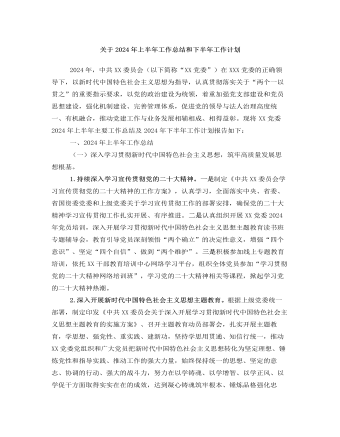
关于2024年上半年工作总结和下半年工作计划
二是深耕意识形态。加强意识形态、网络舆论阵地建设和管理,把握重大时间节点,科学分析研判意识形态领域情况,旗帜鲜明反对和抵制各种错误观点,有效防范处置风险隐患。积极响应和高效落实上级党委的决策部署,确保执行不偏向、不变通、不走样。(二)全面深化党的组织建设,锻造坚强有力的基层党组织。一是提高基层党组织建设力量。压实党建责任,从政治高度检视分析党建工作短板弱项,有针对性提出改进工作的思路和办法。持续优化党建考核评价体系。二是纵深推进基层党建,打造坚强战斗堡垒。创新实施党建工作模式,继续打造党建品牌,抓实“五强五化”党组织创建,广泛开展党员教育学习活动,以实际行动推动党建工作和经营发展目标同向、部署同步、工作同力。三是加强高素质专业化党员队伍管理。配齐配强支部党务工作者,把党务工作岗位作为培养锻炼干部的重要平台。
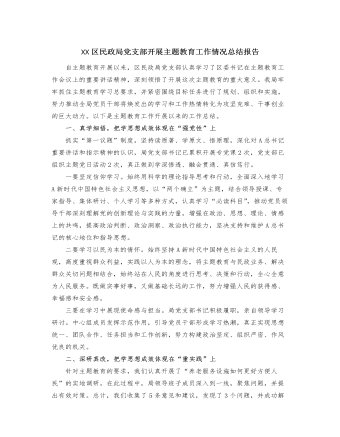
XX区民政局党支部开展主题教育工作情况总结报告
二要专注于解决问题。根据市委促进经济转型的总要求,聚焦“四个经济”和“双中心”的建设,深入了解基层科技工作、学术交流、组织建设等方面的实际情况,全面了解群众的真实需求,解决相关问题,并针对科技工作中存在的问题,采取实际措施,推动问题的实际解决。三要专注于急难愁盼问题。优化“民声热线”,推动解决一系列基层民生问题,努力将“民声热线”打造成主题教育的关键工具和展示平台。目前,“民声热线”已回应了群众的8个政策问题,并成功解决其中7个问题,真正使人民群众感受到了实质性的变化和效果。接下来,我局将继续深入学习主题教育的精神,借鉴其他单位的优秀经验和方法,以更高的要求、更严格的纪律、更实际的措施和更好的成果,不断深化主题教育的实施,展现新的风貌和活力。
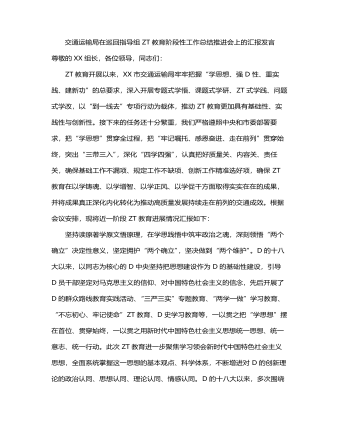
交通运输局在巡回指导组主题教育阶段性工作总结推进会上的汇报发言
今年3月,市政府出台《关于加快打造更具特色的“水运XX”的意见》,提出到2025年,“苏南运河全线达到准二级,实现2000吨级舶全天候畅行”。作为“水运XX”建设首战,谏壁闸一线闸扩容工程开工在即,但项目开工前还有许多实际问题亟需解决。结合“到一线去”专项行动,我们深入到谏壁闸一线,详细了解工程前期进展,实地察看谏壁闸周边环境和舶通航情况,不断完善施工设计方案。牢牢把握高质量发展这个首要任务,在学思践悟中开创建功之业,坚定扛起“走在前、挑大梁、多做贡献”的交通责任,奋力推动交通运输高质量发展持续走在前列。以学促干建新功,关键在推动高质量发展持续走在前列。新时代中国特色社会主义思想着重强调立足新发展阶段、贯彻新发展理念、构建新发展格局,推动高质量发展,提出了新发展阶段我国经济高质量发展要坚持的主线、重大战略目标、工作总基调和方法论等,深刻体现了这一思想的重要实践价值。
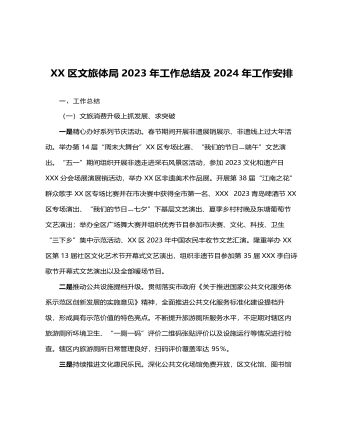
XX区文旅体局2023年工作总结 及2024年工作安排
三、2024年工作计划一是完善基层公共文化服务管理标准化模式,持续在公共文化服务精准化上探索创新,围绕群众需求,不断调整公共文化服务内容和形式,提升群众满意度。推进乡镇(街道)“114861”工程和农村文化“121616”工程,加大已开展活动的上传力度,确保年度目标任务按时保质保量完成。服务“双减”政策,持续做好校外培训机构审批工作,结合我区工作实际和文旅资源优势,进一步丰富我市义务教育阶段学生“双减”后的课外文化生活,推动“双减”政策走深走实。二是结合文旅产业融合发展示范区,全力推进全域旅游示范区创建,严格按照《国家全域旅游示范区验收标准》要求,极推动旅游产品全域布局、旅游要素全域配置、旅游设施全域优化、旅游产业全域覆盖。
今日更新Word
-

精选高中生期末评语
1、该生学习态度端正 ,能够积极配合老师 ,善于调动课堂气氛。 能够积极完成老师布置的任务。学习劲头足,听课又专注 ,做事更认 真 ,你是同学们学习的榜样。但是,成绩只代表昨天,并不能说明你 明天就一定也很优秀。所以,每个人都应该把成绩当作自己腾飞的起 点。2、 你不爱说话 ,但勤奋好学,诚实可爱;你做事踏实、认真、为 人忠厚 ,是一个品行端正、有上进心、有良好的道德修养的好学生。在学习上,积极、主动,能按时完成老师布置的作业,经过努力 ,各 科成绩都有明显进步,你有较强的思维能力和学习领悟力,学习也有 计划性,但在老师看来,你的潜力还没有完全发挥出来,学习上还要有持久的恒心和顽强的毅力。
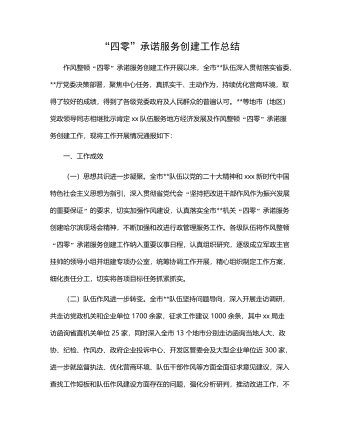
“四零”承诺服务创建工作总结
(二)坚持问题导向,持续改进工作。要继续在提高工作效率和服务质量上下功夫,积极学习借鉴其他部门及xx关于“四零”承诺服务创建工作的先进经验,同时主动查找并着力解决困扰企业和群众办事创业的难点问题。要进一步探索创新,继续优化工作流程,精简审批程序,缩短办事路径,压缩办理时限,深化政务公开,努力为企业当好“保姆”,为群众提供便利,不断适应新时代人民群众对政务服务的新需求。(三)深化内外宣传,树立良好形象。要深入挖掘并及时总结作风整顿“四零”承诺服务创建工作中形成的典型经验做法,进一步强化内部宣传与工作交流,推动全市创建工作质效整体提升。要面向社会和公众庄严承诺并积极践诺,主动接受监督,同时要依托电台、电视台、报纸及微信、微博等各类媒体大力宣传xx队伍作风整顿“四零”承诺服务创建工作成果,不断扩大社会知情面和群众知晓率。

2024年度工作计划汇编(18篇)
1.市政基础设施项目5项,总建设里程2.13km,投资概算2.28亿元。其中,烔炀大道(涉铁)工程施工单位已进场,项目部基本建成,正在办理临时用地、用电及用水等相关工作;中铁佰和佰乐(巢湖)二期10KV外线工程已签订施工合同;黄麓镇健康路、纬四路新建工程均已完成清单初稿编制,亟需黄麓镇完成图审工作和健康路新建工程的前期证件办理;公安学院配套道路项目在黄麓镇完成围墙建设后即可进场施工。2.公益性建设项目6项,总建筑面积15.62万㎡,投资概算10.41亿元。其中,居巢区职业教育中心新建工程、巢湖市世纪新都小学扩建工程已完成施工、监理招标挂网,2月上旬完成全部招标工作;合肥职业技术学院大维修三期已完成招标工作,近期签订施工合同后组织进场施工;半汤疗养院净化和医用气体工程已完成招标工作;半汤疗养院智能化工程因投诉暂时中止;巢湖市中医院(中西医结合医院)新建工程正在按照既定计划推进,预计4月中下旬挂网招标。

驻村工作队2024年第一季度工作总结汇编(4篇)
三是做大做强海产品自主品牌。工作队于xx年指导成立的冬松村海产品合作社,通过与消费帮扶平台合作,在工作队各派出单位、社会团体、个人支持下,已获得逾xx万元销售额。2022年底工作队推动合作社海产品加工点扩建的工作方案已获批,待资金下拨后将正式启动扩建工作。四是积极助企纾困,带动群众增收致富。工作队利用去年建立的xx镇产业发展工作群,收集本地企业在产品销售、技术、人力、资金、运营、用地等方面的需求,并加大xx支持乡村振兴力度,xx助理赴各村委开展多场xx政策支持乡村振兴宣讲活动,本季度有x万元助农贷款获批,xx万贷款正在审批中。在壮大既有产业的同时,完善联农带农机制,一方面鼓励企业雇用本地农户就业,另一方面计划与本地农户签订长期收购合同,让农民种得放心、种得安心,带动当地群众共同致富。

主题教育总结常用提纲大全
第一,主题教育是一次思想作风的深刻洗礼,初心传统进一步得到回归。第二,主题教育是一次沉疴积弊的集中清扫,突出问题进一步得到整治。第三,主题教育是一次强化为民服务的生动实践,赤子之情进一步得到提振。第四,主题教育是一次激发创业担当的有利契机,发展层次进一步得到提升。2.第一,必须提领思想、武装思想。第二,必须聚焦问题、由表及里。第三,必须领导带头、以上率下。第四,必须务实求实、认真较真。3.一是抬高政治站位,坚持大事大抓。二是坚持思想领先,狠抓学习教育。三是突出问题导向,深入整改纠治。四是坚持领导带头,发挥表率作用。4.一是立足“早”字抓筹划。二是着眼“活”字抓学习。三是围绕“统”字抓协调。5.一是形势所需。二是任务所系。三是职责所在。四是制度所定。6.一要提升认识。二要积极作为。三要密切协作。
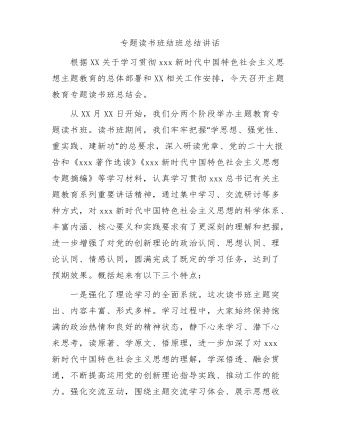
主题教育专题读书班结班总结讲话
第二,要把调查研究贯穿始终,实干担当促进发展。开展好“察实情、出实招”“破难题、促发展”“办实事、解民忧”专项行动,以强化理论学习指导发展实践,以深化调查研究推动解决发展难题。领导班子成员要每人牵头XX个课题开展调查研究,XX月底前召开调研成果交流会,集思广益研究对策措施。各部门、各单位要制定调研计划,通过座谈访谈、问卷调查、统计分析等方式开展调查研究,解决工作实际问题,帮助基层单位和客户解决实际困难。第三,要把检视问题贯穿始终,廉洁奉公树立新风。认真落实公司主题教育整改整治工作方案要求,坚持边学习、边对照、边检视、边整改,对标对表xxx新时代中国特色社会主义思想,深入查摆不足,系统梳理调查研究发现的问题、推动发展遇到的问题、群众反映强烈的问题,结合巡视巡察、审计和内外部监督检查发现的问题,形成问题清单。










